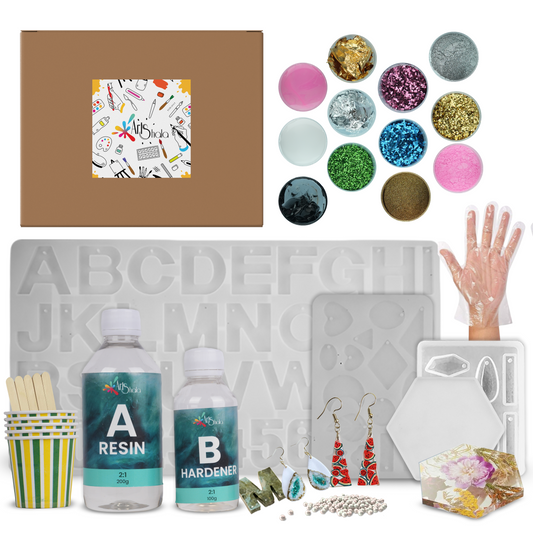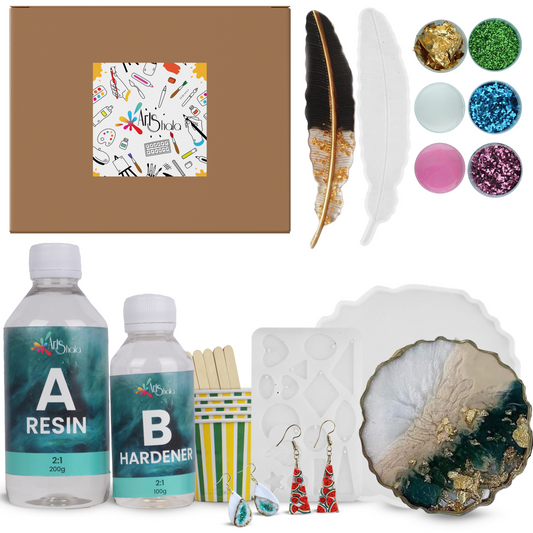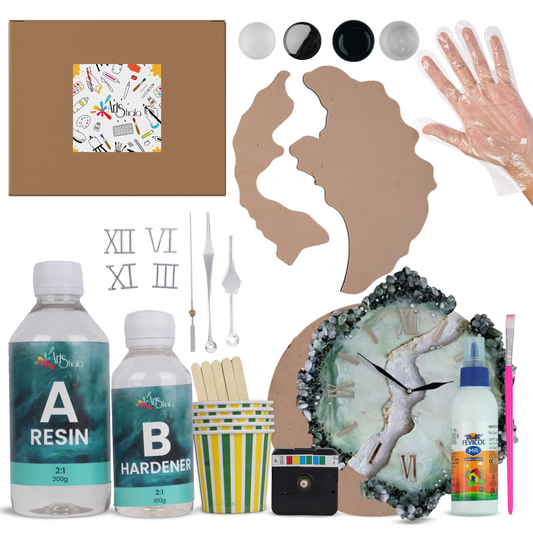How to Create Stunning Bubble Texture with UV Resin?
With its fast curing times and crystal clear finish, UV resin has become a favourite material for crafters and artists alike. But did you know you can take your resin projects to a new level by adding a whimsy bubble texture? This technique is surprisingly simple and opens doors to unique and eye-catching creations.
In this comprehensive guide, we'll cover everything you need to know about creating captivating bubble textures with UV resin, from gathering materials to achieving the perfect bubbly finish. To learn more about such techniques, enrol in a resin art workshop.
What You'll Need to Create Bubble Texture with UV Resin?
- UV Resin: This is the star of the show! Choose a high-quality UV resin brand that cures well under your UV lamp.
- UV Lamp: A UV lamp is essential for curing UV resin quickly and efficiently. Make sure the wattage of your lamp is compatible with the resin brand you have chosen.
- Safety Gear: Always prioritise safety when working with resin. Wear gloves and a respirator to avoid contact and inhalation.
- Mixing Containers: Disposable plastic cups or small beakers work well for mixing resin.
- Stir Sticks: These will help you mix the resin thoroughly.
- Mould or Bezels: Depending on your project, you can use silicone moulds to create specific shapes or bezels for jewellery pieces.
- Dish Soap: A mild dish soap is critical to creating long-lasting bubbles.
- Water: You'll need some water to create the bubbly solution.
- Spoons or Straws: These will help you create and manipulate the bubbles.
- Optional: Alcohol wipes or a heat gun can help remove unwanted bubbles in the resin itself before adding the decorative bubbles.
- Project Inspiration: Browse online resources or have a creative vision for your project before diving in.
Steps to Bringing the Bubbles to Life
- Prepare Your Workspace: To protect your work surface, choose a clean, well-ventilated area covered with newspaper or a disposable tablecloth.
- Mix the Resin: Carefully mix your UV resin following the manufacturer's instructions. Remember to stir slowly and scrape the sides of the container to ensure proper mixing.
- Prime Your Mould or Bezel (Optional): For some projects, create a solid base layer of cured resin before adding the bubbles. This can be extremely helpful if you're utilising deep moulds.
- Create the Bubble Solution: Mix a small amount of dish soap with water in a separate container. The exact ratio will rely on the type of soap and your desired bubble size. Experiment to find a good balance – too much soap can cause the bubbles to pop easily, while too little may not create enough bubbles.
- Generate Bubbles: Agitate the soapy water using a whisk or simply by hand to create a generous amount of bubbles. You can also utilise a straw to blow bubbles directly onto the surface.
- Apply the Bubbles: Gently skim the top layer of bubbles with a spoon or another flat tool. Carefully transfer these bubbles onto the uncured resin surface. Aim for an even distribution, but don't worry about complete coverage – some peeking through the bubbles can add depth.
- Cure the Resin: Place your project under the UV lamp, following the recommended curing time for your specific resin brand. The bubbles will solidify as the resin cures.
- Clean Up and Remove Excess Bubbles: Once the resin is fully cured, use gloves to carefully remove any unwanted bubbles that may have formed in the resin itself. You can use a toothpick dipped in alcohol or a carefully aimed heat gun (be sure to follow safety instructions) to pop these.
Tips and Tricks for Success
- Work Quickly: Bubbles tend to pop, so try to work efficiently when applying them to the resin.
- Bubble Size Variation: Use a combination of large and small bubbles for a more natural and exciting texture.
- Experiment with Color: For an extra pop, add a touch of coloured pigment to your resin before pouring.
- Practice Makes Perfect: Don't be discouraged if your first attempt isn't exactly what you envisioned. Resin art is all about experimentation, so have fun and keep practising!
Exploring Creative Techniques with Bubble Resin
Now that you've mastered the basic technique of creating bubble texture with UV resin let's explore creative ways to elevate your projects and create unique effects.
1. Coloured Bubbles
- Soap Colourant: Add a few drops of non-oil-based soap colourant to your bubble solution for a subtle hint of colour in the bubbles. Experiment with different colour combinations for a playful touch.
- Alcohol Ink: For more vibrant coloured bubbles, try dipping a toothpick or needle in alcohol ink and carefully touching the surface of individual bubbles. The ink will spread within the bubble, creating a beautiful marbled effect.
2. Double Bubble Trouble
Make a layered effect by pouring a light layer of clear resin, curing it partially, and then adding your bubbles. Once the bubbles are cured, pour another layer of clear resin to encase them. This technique creates a dimensional look with bubbles seemingly suspended within the resin.
3. Metallic Magic
For a touch of luxury, incorporate metallic elements into your bubble resin. Here are two ways to achieve this:
- Metallic Flakes: Sprinkle a small amount of metallic flakes onto the uncured resin before adding the bubbles. The flakes will catch the light and add a shimmery dimension to your project.
- Gilded Bubbles: Before applying the bubbles to the resin, use a paintbrush to coat them with metallic leaves or metallic paint lightly. This creates a luxurious, almost antiqued look to your bubbles.
4. Underwater Dreamscapes
For a captivating oceanic feel, use shades of blue and green resin to create a layered background. Then, incorporate white or pearlescent bubbles to resemble underwater air bubbles. Add tiny shells or other ocean-themed embellishments for an extra touch of realism.
5. Textured Delights
Don't limit yourself to smooth surfaces! Experiment with textured moulds or bezels to create a more exciting backdrop for your bubbles. Think wrinkled silicone moulds, textured metal bezels, or even real leaves or flowers cast in resin (make sure they are scorched before encasing them). The contrasting textures will add depth and visual intrigue to your project.












